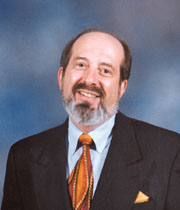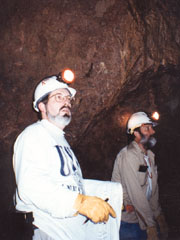Casting Light
On Our Treasures
By Valerie N. Kaufman
It all began
in the basement of a house in the mountains of Western Maryland,
with a little boy putting on neighborhood plays and spending weeks
preparing the lights of his train set so it was just right for
Christmas Day. Today, that little boy, Frank Florentine, is a
grown man, and he is responsible for designing the lighting for
some of the nation's most important artifacts, including the Wright
brothers' airplane, the first aircraft to travel the speed of
sound, and the first spacecraft to leave our solar system.
 "It's ironic. I started working at the Smithsonian after my sister
asked me when I was going to get a real job," he recalled. "Now
I get to climb into spaceships and airplanes as part of my job."
"It's ironic. I started working at the Smithsonian after my sister
asked me when I was going to get a real job," he recalled. "Now
I get to climb into spaceships and airplanes as part of my job."
Florentine, a 12-year resident of Annapolis, has been the lighting
designer for the National Air and Space Museum (NASM) in Washington,
D.C., since 1985. His responsibilities include designing and maintaining
the lighting for all exhibits within the museum.
"It doesn't always seem real to me. Sometimes when I'm sitting
in a space capsule, I just have to stop and pause to think that
much greater men than me have been where I am," he says.
As part of his job at NASM, Florentine also conducts photometric
studies to determine whether ultraviolet radiation from both daylight
and electrical light is affecting artifacts within the museum.
"We have to take great care with these items so that they will
last for many years to come," he says.
Florentine's love of lighting began at an early age. It developed
as he grew up playing in the theater that his father managed in
Cumberland, Md. Cumberland was Florentine's hometown and, at the
time, a major stopover for vaudeville.
Those traveling variety shows inspired him to attend Frostburg
State College (now Frostburg State University) and major in speech
and drama with an emphasis on technical theater. He later went
on to achieve a master's in fine arts from George Washington University.
After college, Florentine held several jobs in the theater---as
a stage technician for the Lisner Auditorium at George Washington,
a production manager/lighting designer for the Washington Ballet,
and as a technical director for the Wolf Trap Farm Park for the
Performing Arts.
In 1979, he toured with Russia's Bolshoi Ballet throughout the
U. S., serving as the troupe's stage manager. That opportunity
led him to another, as the production manager for Rudolf Nureyev's
performance of Don Quixote. From January '82 to June
'84, he toured some 65,000 miles with the show.
Mementos from this time still hang on the walls of his home. His
upstairs office is lined with posters of Nureyev, pictures of
his coworkers and other memorabilia.
"I still remember when I heard that Nureyev had died," he says.
"The news made me cry."
One of Florentine's proudest moments occurred when he was traveling
with Nureyev in Sicily. The performance took place on a stage
perched on top of a mountain. Behind it was a brilliant blue sky.
According to Florentine, there was just too much beautiful natural
scenery to compete with, making his job incredibly difficult.
"But at the end of the show, Nureyev looked over to me and nodded
to say thank you," he says. "It really meant a lot to me."
Over the years, Florentine's love for his work has not diminished.
In fact, it's not just a 9-to-5 job for him. It's a calling. During
the winter months, he spends much of his free time doing freelance
lighting jobs. Over the years, he has designed lighting for everything
from homes to art galleries, wildlife centers to caverns.
 Lighting the Kartchner Caverns, located at the Kartchner Caverns
State Park near Benson, Ariz., is a work in progress for Florentine.
He began the job in 1997. At first he wasn't sure if he wanted
to take on a task of this magnitude but, after discussing it with
his wife, he decided it was a chance of a lifetime.
Lighting the Kartchner Caverns, located at the Kartchner Caverns
State Park near Benson, Ariz., is a work in progress for Florentine.
He began the job in 1997. At first he wasn't sure if he wanted
to take on a task of this magnitude but, after discussing it with
his wife, he decided it was a chance of a lifetime.
During his first visit to the cavern, Florentine entered a portion
that had yet to be developed so he could get a feel for the space.
"Once inside, we turned off our lights. As we sat there in the
dark, we heard a drop of water echo throughout the room," he says.
"That sound inspired me. I decided right then that it would take
just a drop of light to penetrate the cave and make it beautiful."
As he progressed through the first phase of the project---which
was expected to take six months but, instead, took two years---Florentine
experimented with colored lighting. In the end, however, he decided
to go with light that resembled that which is used on a caver's
helmet.
Florentine found the lighting of the cave's Throne Room to be
one of the biggest challenges of the project. This is the area
where the commercial tour ends with a music and light show which
centers on the 58-foot-tall Kubla Khan column. The lighting had
to be designed around the timing of music and highlight the natural
beauty of the formations. When completed, Florentine explains,
the lighting enhanced the music.
"It was amazing when we finished. People who had seen the cavern
for years were standing there crying," he recalls. "When they
saw it with the lighting, they saw just how beautiful it really
was."
Even when he's not doing freelance work, he just can't tear himself
away from lighting design. In fact, he has found a way to combine
his love for lighting with one of his other great loves, sailing.
Each year, Florentine, along with his friend Howard Newman, organizes
and designs the Parade of Lights entry for his sailing club, Singles
on Sailboats.
"Luckily they let you stay a member after you get married," said
Florentine, who has been married to his wife Susan Cook, a lawyer
for the Department of Justice, for 12 years.
It was sailing that first drew Florentine to Annapolis, but it
is the sense of community that keeps him here. People really take
the time to get to know you, he says.
Last year, his sailing club's entry for the parade was a spectacular
rendition of the Grinch and Santa Claus fighting over a sack of
toys. As they wrestled for the bag, it tore open and out came
a sailboat.
According to Florentine, work on the entry usually begins in August.
He and Newman come up with the idea at that time and begin the
design. Then members of the sailing group get together for three
weekends and put it all together. He admits, however, that this
year's creation is a little behind schedule.
"Creating this each year is a lot of fun," he exclaims. "It truly
is a labor of love for me."
Though he enjoys riding on his creation, he also takes pleasure
in seeing how his audience reacts. One year, he remembers walking
downtown during the parade. As his club's entry went by, a mother
and young child were watching. Their delight in the light display
made all the work worthwhile.
"No matter what the job, when you are standing there looking at
the finished product---seeing the magic of what you've done---that's
the most rewarding feeling," he says.
Back
|

